#folclorico
Text
this specifically goes to @crystalmagpie447
i just cant remember why

anyways folclorico sun doodle
#EXPECT MORE OF THIS I THINK ITS SILLY#HEHE#crystal i feel like this brainrot is ur fault i just dont know WHY#JHEJHJHJ????#dca#folclorico#ft me#i actually did a folclorico dance in a dress it was so much fun but heres me in a sombrero instead with tacones#jerrsterrr art#I HAVE SO MUCH ARTBLOCK HOW DID THIS BYPASS MY BRAIN
73 notes
·
View notes
Photo

Adentro Cojutepeque #baile #bailarin #dance #dancer #folkloric #elsalvador #folclorico #latino #danza https://www.instagram.com/p/CoIP8IRu7lk/?igshid=NGJjMDIxMWI=
1 note
·
View note
Text
Falleció el compositor Jorge Milikota
Falleció el compositor Jorge Milikota
Todavía no han trascendido detalles del contexto en el que se dió el desenlace pero fuentes cercanas al músico confirmaron la noticia.
Jorge Omar Milikota nació un 1 de Noviembre, 1955, en San José de La Esquina, Provincia de Santa Fe. Músico guitarrista, notable compositor y autor de temas como Zamba de amor en vuelo y Jazmín de luna. Referente autoral de diferentes generaciones.
Durante una…

View On WordPress
0 notes
Photo

The Leyenda family sharing: Always be you, because that is magical in a beautiful way. http://balletfolkloricoleyenda.com . . @anthony_alviar012 @ashleyperez04_ . . #bedifferentbeyou #stayunique #yourway #balletfolklorico #balletfolkloricoleyenda #leyendaballetfolklorico #folklorico #folclorico #folklore #danzafolklorica #folkdance #mexicandance #mexicandancers #bailefolklorico #mexicanstyle #mexicanculture #mexicanvibes #mexicanpride #mexicanheritage #youknowyouremexican #growingupmexican #mexicansbelike #mexicansbelike🇲🇽 https://www.instagram.com/p/CgDTUAMPUWx/?igshid=NGJjMDIxMWI=
#bedifferentbeyou#stayunique#yourway#balletfolklorico#balletfolkloricoleyenda#leyendaballetfolklorico#folklorico#folclorico#folklore#danzafolklorica#folkdance#mexicandance#mexicandancers#bailefolklorico#mexicanstyle#mexicanculture#mexicanvibes#mexicanpride#mexicanheritage#youknowyouremexican#growingupmexican#mexicansbelike#mexicansbelike🇲🇽
0 notes
Photo

In the pool Complete drawing #expressionism #escultura #artdrawing #aesthetic #oaxaca #pool #kunstler #kunst #arte #artbrute #folkartist #folclorico #color #forma #moneros #adriandordelly https://www.instagram.com/p/CfjQbPgO4_m/?igshid=NGJjMDIxMWI=
#expressionism#escultura#artdrawing#aesthetic#oaxaca#pool#kunstler#kunst#arte#artbrute#folkartist#folclorico#color#forma#moneros#adriandordelly
0 notes
Photo
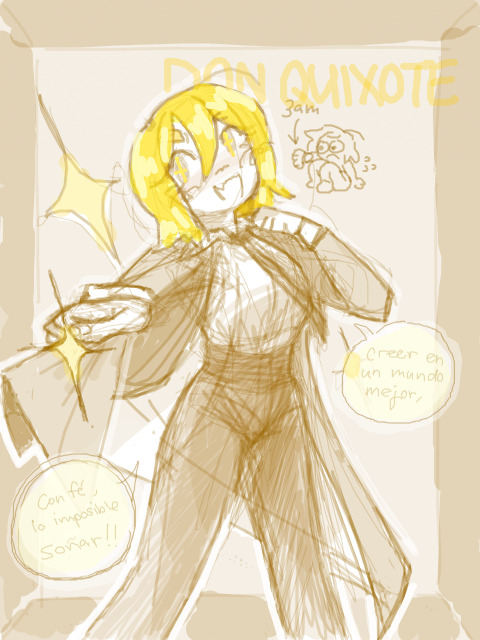
i don’t go here but i love u quixote...
#actually thats a lie i do go here#but i only go to lobcorp so i have no idea what everything else is about lol#i just wanted her to hold her coat like a folclorico dress qq#tegaki#don quixote#limbus company#bowl doodles
33 notes
·
View notes
Text
Honey wake up new euphemism for queer: folklore
5 notes
·
View notes
Note
hi I had to follow you after I saw your Ballet De Florico dancer Marcelle and the caption implies you made similar drawings for other characters! I'm not Mexican but I used to do Ballet De Florico when I was little and it has a very special place in my heart, so whenever I see it I get very excited and happy and I really admire the women who do it professionally, so seeing one of my favorite characters in the get-up just made me go "💖💖💖" thank you for making such amazing art!!!
thank you so much!!! i used to do folclorico too when i was little, so it has a very special place in my heart <3
9 notes
·
View notes
Photo

DISCOVER MUSIC FROM THE PACIFIC WITH ARC MUSIC (CD) Compilation
Song listing:
1. Tonga: The Singing Reef - Field rec. David Fanshawe
2. Marquesas Islands: Mave (Welcome Rite) - Voix de Iles (trad.)
3. Fiji: Orchid island Group - Field rec. David Fanshawe (trad.)
4. Chuuk, Micronesia: Romonum I - Field rec. David Fanshawe (trad.)
5. New Zealand: E Ko Te Te Kautoki - Kahurangi Maori (trad., arr. Kahurangi)
6. Tahiti: Aparima Te Maeva - Field rec. David Fanshawe (Coco Hotahota)
7. Hawaii: Na Po - Halau Hula Ka No’eau (trad.)
8. Tokelau: Te namo - Te Vaka (Opetaia Foa’i)
9. Tahiti: Haere mai - Tahiti Here (trad.)
10. Tonga: The Nobleman Ve’ehala - Field rec. David Fanshawe (trad.)
11. Tonga: Old Timers’ Dateline Hotel - Field rec. David Fanshawe (trad.)
12. Solomon Islands: Gilo Stones - Field rec. David Fanshawe (trad.)
13. Easter Island: Himno, Moto Nui, Kia Kia - Conjunto Folclorico “Danzamerica” de Chile (trad.)
14. Fiji: Bula - Nawaka Entertainment Group (trad.)
15. Kiribati: Te Kamei Batere - Field rec. David Fanshawe (trad.)
16. Tokelau: Ki mua - Te Vaka (Opetaia Foa’i)
17. Hawaii: Hawaiian Lullaby - Harry Kalapana (Hougassian/Robinot)
18. Society Islands: Himene Tarava Anau - Field rec. David Fanshawe (trad.)
19. West Samoa: Fiafia at Aggie Grey’s - Field rec. David Fanshawe (trad.)
20. Cook Islands: Reureu Drum Dance - Field rec. David Fanshawe (trad.)
21. New Zealand: Haka hou Kahurangi Maori (trad., arr. Kahurangi)
22. Cook Islands: The Singing Reef 1 - Field rec. David Fanshawe
2 notes
·
View notes
Text
ahsoka es loputo mejor
despus de 6 meses de ver todo star wars por fin e llegado a ahsoka, tenia las expectativas medias. habia visto muchos comentarios negativos pero tambn positivos. pero lo que no me esperava era encontrarme con una de las mejores series que e visto, pero lo hize. no seris de star wars series y punto. me quedan 2 caps para terminarla y guau, nunca pense en ver algo tan buno. es MUY diferente al star wars tradisional pero al msmo tempo es lacosas MAS tradicionl que an echo. creo qu la mejor forma de explicarlo es que es un cuento de adas. es una serie llena de magia y lo intersante es que ES CONSIENTE DE ESO, estan hablando constantemnte de cuentosn de fantasia y adas ,tirras prometidas cuentos folcloricos !TODA LA SERIE S SOBRE ESO! y es hermoso. ose savan que esta va a ser una de las historias mas fantaciosas de star wars y lo disidieron hacer todo elevado a la 1000, tenes brujas caballeros en armaduras tierras magicas !EL PUTO ROBOT DISE "HACE MUCHO TIEMPO EN UNA GALACSIA MUY MUY LEJANA"!!!! osea aaaaaaaaaa es liter la mejor cosa que e visto. ademas me encanta como no solo la serie es consiente de su fantacia clasica de cuentos folcloricos sino tamben los personajes. constantemnte tenes jente que esta fuera del circulo social de "los favoritos de la fuersa' preguntando qu carajo esta pasando, poque osea como espectadores nosotros savemos que eso existe y pasa pero para la jente de hay esta como "como que ballenas voladoras que viajan en el iperspacio? estas drogado o que". en fn esta serie me parese asombrosa. lo uncio "malo" que no es malo solo me hace sentir triste es que es una de las historias que mas finaliza? osea la mayoria de las sries y peliculas son de finales habiertos. en el eho de que dan un final a la hisoria no al mudno, mientras esta si, esta quiere dar un final a el mundo. y la verdad es que aunque me entristsca tamben me emosiona locamente. estoy ansosa por el que pasara .
1 note
·
View note
Photo
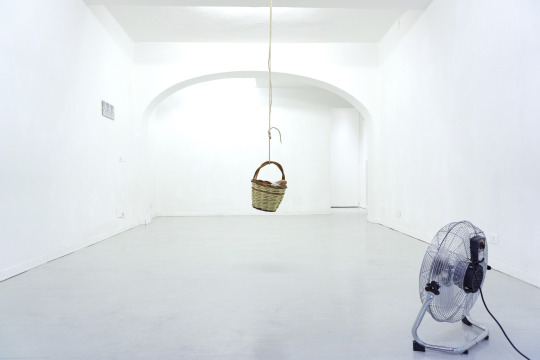

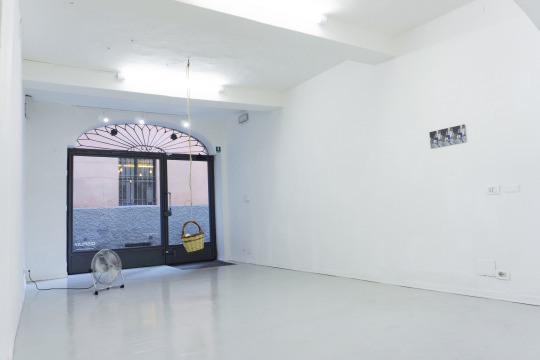
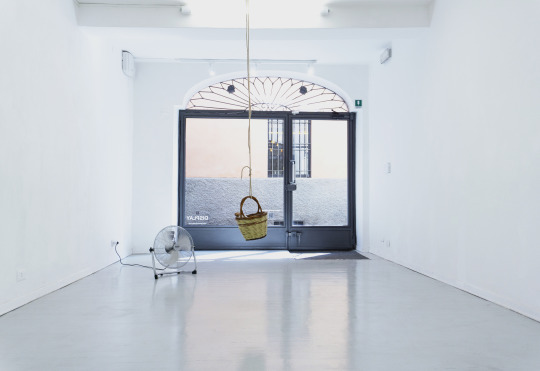
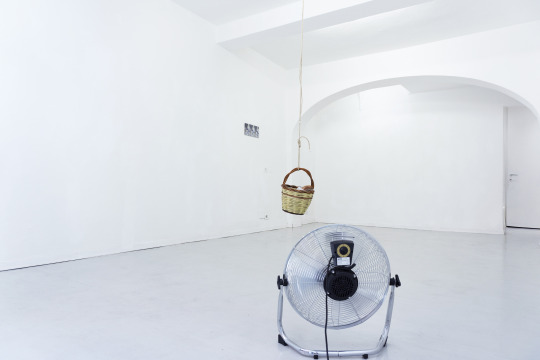
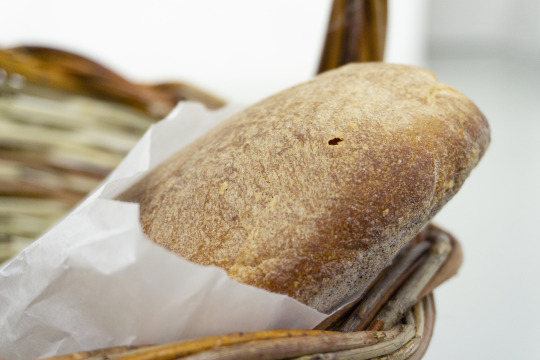



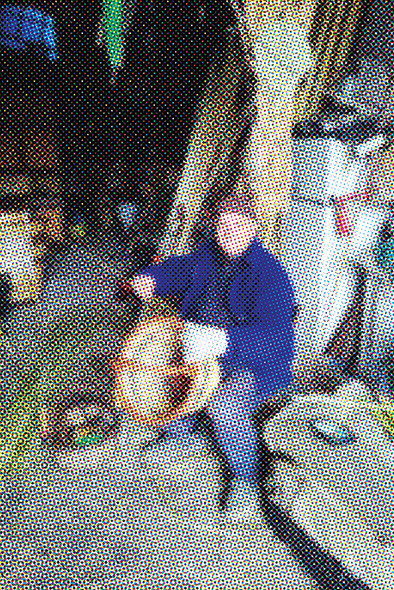
Fabrice Bernasconi Borzì
E’ questo che sognavo da bambino? (Part II)
27.05.2023 - 09.07.2023
(a cura di Ilaria Monti)
Un paniere scende lento dal balcone di una casa, in risposta al grido dal basso di un uomo o una donna: “Cala u panaru!”. Scende e sale il pane caldo come un piccolo miracolo custodito in un cesto di rami intrecciati. Consumato il pane, tutti scompaiono, nessun vociare tra i cortili condominiali, nessun rumore di pentole e cassetti dalle cucine. Resta il silenzio, il paniere di briciole che oscilla per una corrente d’aria o un vento da chissàdove, venti moderati dai quadranti nord occidentali, il Maestrale, lo Scirocco. È questo che sognavi da bambino, Fabrice?
L’immagine del tipico panaru siciliano, cristallizzata dall’artista in questa seconda parte di un più ampio progetto dedicato al recupero delle proprie radici italiane, è una cartolina nostalgica di un viaggio a ritroso dalla Ginevra a Catania. Il paniere, che l’artista lascia pieno e sospeso nel vuoto, evoca abitudini, rituali e necessità che ad oggi sopravvivono nelle comunità del Sud Italia e del Mediterraneo come pratiche ancora in atto o, in qualche caso, come souvenir turistici. Tra i rami e le fibre del cesto, frutto di una cura e di un sapere artigiano, Fabrice Bernasconi ripercorre la storia di un mestiere tradizionale e antico quale quello dei canestrai e, con pochi altri elementi – il pane della sua terra, una leggera brezza – suggerisce una precisa dimensione geografica e antropologica, la sradica e poi la porta con sé. Il risultato è ironico e insieme poetico: come in un sogno di cui resta soltanto un ricordo mosso, l’artista crea una visione sintetica, che possa rintracciare e ricostruire l’esperienza vissuta. Quei venti che scuotono panieri e panni stesi, allora, soffiano da un semplice ventilatore. In questo necessario confronto tra tecnologia e artigianalità, gli elementi dell’opera stridono parlando due lingue diverse. Richiamando un oggetto folclorico e i simboli di una cultura locale, l’opera mette in gioco, provocatoriamente, certe dinamiche dello sguardo e della sua fascinazione per l’altrove. Si torna nel proprio luogo natale e dopo anni e lo si riscopre attraverso piccoli gesti quotidiani o oggetti che avevamo dimenticato. Si va per paesi prima sconosciuti, con la fame di coglierne la verità più essenziale che solo la vita quotidiana riesce a rivelare, affascinati da forme del sacro che non ci appartengono. Così la dimensione puramente contemplativa dell’opera genera una forma di spaesamento che non potrebbe trovare corrispondenza migliore di questi versi del peota Giorgio Caproni (da Il muro della Terra, 1975):
Sono tornato là
dove non ero mai stato.
Nulla, da come non fu, è mutato.
Sul tavolo (sull’incerato
a quadretti) ammezzato
ho ritrovato il bicchiere
mai riempito. Tutto
è ancora rimasto quale
mai l’avevo lasciato.
Decontestualizzando e defunzionalizzando il simbolo e la sua storia, l’artista crea dunque un’immagine residua: alla fine del giorno e alla fine del sogno, restano come avanzi o come fantasmi i ricordi, le vite degli altri, il tempo lungo di gesti reiterati, sempre uguali. E da questi residui l’artista compone un sistema simbolico immediato ed essenziale, ma complesso: il pane che nessuno ha consumato è la terra e il suo grano, è morte, fede, superstizione, nutrimento e fame, è il susseguirsi delle stagioni, è la semina, ai primordi della cultura e della τέχνη, nel senso più profondo della mano che produce e mette in opera quanto appreso dall’esperienza del mondo. È questo che sognavi da bambino, Fabrice? Anche questo, e tanto basta.
BIO
Fabrice Bernasconi Borzì, (Ginevra, 1989), vive e lavora a Catania. Nel 2016 si laurea in Arti Visive - (de)costruzione e gestione dello spazio alla Haute École d’Art et de Desgin de Genève. Dal 2018 si trasferisce a Catania, dove consegue il diploma di II livello presso l’Accademia di Belle Arti. Tra le mostre più recenti: Biennale dei giovani artisti italiani under 35, Monza (upcoming, 2023); Abbandonarsi ogni tanto è utile, Galleria Massimo Ligreggi, Catania; 2022, Oh, i am just visiting, BOCS - Box of Contemporary Space, Catania; 2021, Impro#1, Galleria Massimo Ligreggi, Catania, 2021; Sine die, Fondazione Oelle/Palazzo della cultura, Catania; 2019, Geografico #Sicilia, a cura di Pietro Fortuna nell’ambito del progetto Border Crossing ideato da Bridge Art, Dimora Oz e Casa Sponge, Palermo, varie sedi, 2019; AD IN VISIBILIA, Fondazione Brodbeck, Catania,; 2018, Garden of the forking paths, MANIFESTA 12, Palermo, 2018 5x5x5 collateral event, Palermo, 2018. È tra i finalisti dell’Exibart Prize 2021; nel 2019 vince il Premio Nazionale delle Arti per la sezione opere interattive.
http://fabricebernasconiborzi.com
____________________
ENGLISH
(curated by Ilaria Monti)
A basket slowly descends from the balcony of a house in response to the shout of a man or woman from below: "Cala u panaru!"(“drop the basket off). Down comes and up goes the warm bread like a little miracle kept safe in a wicker basket. Once there’s no bread left, everyone disappears, no hubbub from the houses’courtyards, no clattering of pots and drawers from the kitchens. Only silence remains, and some crumbs in the basket swaying for an airflow or a breeze from who knows where – moderate winds from the northwestern quadrants, the Mistral, the Sirocco. Is this what you dreamed of as a child, Fabrice?
The image of the typical Sicilian panaru, crystallized by the artist in this second part of a wider project devoted to recovering his Italian roots, is a nostalgic postcard of a journey back from Geneva to Catania. The basket filled with bread and hanging in space evokes habits, rituals and necessities wich are still present in Southern Italian and Mediterranean communities, weather as ordinary costumes or as tourist souvenirs. Through the branches and fibers of a handmade basket, Fabrice Bernasconi traces the history of a traditional and ancient craft such as that of the basketry and, with a few other elements - the bread produced in his homeland, a light breeze – he evokes a clear geographic and anthropological dimension, he roots it out and then takes it with him. The result is ironic and poetic at once: like if he was holding on to hazy memories of a dream, the artist creates a synthetic vision that could retrace and reenact the experience lived. So, here those winds shaking baskets and washing lines, blow from a simple fan. In this necessary dialogue between technology and craftsmanship, the elements of the work screech, speaking two different languages. By recalling a folkloric object and the symbols of a local culture, the work defiantly questions certain logics of gaze and its fascination for an “elsewhere”. One comes back to his native place after years, and rediscover it by experiencing the day-to-day life, objects and gestures which had been forgotten. One travels to places unknow before with a hunger to grasp its deepest truth, those things that only everyday life can reveal, fascinated by a foreign sense of sacredness. Thus, the purely contemplative dimension of the work generates a feeling of displacement that could find no better correspondence than these verses of Italian poet Giorgio Caproni, here translated (from The wall of the Earth, 1975):
I have returned there
where I had never been.
Nothing has changed from what it wasn't.
On the table (on the checkered
waxed tablecloth) on the mezzanine
I once again found the glass
never filled. Everything
has stayed as
I had never left it.
By decontextualizing and defunctionalizing the symbol and its history, the artist therefore creates a residual image: at the end of the day and the end of the dream, memories stay like leftovers or ghosts, together with the lives of other and the slow time of repeated gestures that never change. And with these leftovers the artist arranges an immediate and essential, yet articulate, symbolic system: the bread that no one has taken is the earth and its grain, it is death, faith, superstition, nourishment and hunger, it is the succession of seasons, it is sowing at the beginnings of culture and τέχνη, its deepest meaning of the hand that produces and puts into practice what can be learnt from the world. Is this what you dreamed of as a child, Fabrice? There’s that too, and that’s enough.
BIO
Fabrice Bernasconi Borzì, (b. 1989, Geneva), lives and works in Catania, Sicily. In 2016 he received his BA in Visual Art - Deconstruction of Space from Haute École d’Art et de Desgin de Genève. In 2018 moved to Catania, where he graduated at the Academy of Fine Arts. Most recent exhibitions include: Biennale dei giovani artisti italiani under 35, Monza (upcoming, 2023); Abbandonarsi ogni tanto è utile, Massimo Ligreggi Gallery, Catania; 2022, Oh, i am just visiting, BOCS - Box of Contemporary Space, Catania; 2021, Impro#1, Massimo Ligreggi Gallery, Catania, 2021; Sine die, Fondazione Oelle/Palazzo della cultura, Catania; 2019, Geografico #Sicilia, curated by Pietro Fortuna for Border Crossing, at Bridge Art, Dimora Oz and Casa Sponge, Palermo, 2019 ; AD IN VISIBILIA, Fondazione Brodbeck, Catania; 2018, Garden of the forking paths, MANIFESTA 12 Palermo, 2018; 5x5x5 collateral event, Palermo 2018. In 2021 he was shortlisted for the Exibart Prize 2021; In 2019 he won the Premio Nazionale delle Arti for the section interactive works.
http://fabricebernasconiborzi.com
PRESS KIT
ph credit: DISPLAY
vimeo
0 notes
Photo

𝖿іᥒძ s᥆mᥱ𝗍һіᥒg ᥡ᥆ᥙ ᥣ᥆᥎ᥱ 𝗍᥆ ძ᥆ ᥲᥒძ ᥡ᥆ᥙ’ᥣᥣ ᥒᥱ᥎ᥱr һᥲ᥎ᥱ 𝗍᥆ ᥕ᥆rk ᥲ ძᥲᥡ іᥒ ᥡ᥆ᥙr ᥣі𝖿ᥱ. . . . . . . . . . . . . . . #dance #dancer #folkloric #colombia #cumbia #baile #danza #boston #passion #danseur #folclorico #folklorique https://www.instagram.com/p/Cn7QJ6euEEl/?igshid=NGJjMDIxMWI=
1 note
·
View note
Text

Dado que los #occidentales están "matados" con el #islam (dentro de unos años, literalmente estarán ¡matados!) es bueno que aprendan toda la #verdad sobre las enseñanzas que son obligatorias para todo #musulman, y que fueron reveladas en el #corán y la #sunnah, por la sabiduría de #allah y su #mensajero (#Mahoma). Información tomada y traducida del libro de #Abdullah#Aziz que ud puede leer (si sabe #inglés) en islamicbook.com
Iniciamos con los #judios convertidos en #monos (#micos) por el poder de #allah, porque estos quebrantaron el #shabat; y allah en su #misericordia nos da detalles de este acontecimiento; que no tiene ni un registro #histórico o por lo menos #folclorico fuera del #corán; en el corán (en las #suras (#al-baqarah verso 65 y la sura #al-a'raf versos 163 al 165)Imágen 2 de 4
#Islam#occidente#occidentales#verdad#corán#sunnah#abdullah#inglés#histórico#folclórico#allah#sunah#mahoma#judios#monos
0 notes
Photo

Tell us what is your passion. . . . . . #balletfolkloricoleyenda #leyendaballetfolklorico #folklorico #balletfolklorico #folkloricolife #folclorico #bailefolklorico #danzafolklorica #folkdance #folkdancer #mexicana #mexicanstyle #mexicanvibes #growingupmexican #youknowyouremexican #mexicanculture #mexicanheritage #proudmexican (at Orange, California) https://www.instagram.com/p/Cf7jH_tvzQ7/?igshid=NGJjMDIxMWI=
#balletfolkloricoleyenda#leyendaballetfolklorico#folklorico#balletfolklorico#folkloricolife#folclorico#bailefolklorico#danzafolklorica#folkdance#folkdancer#mexicana#mexicanstyle#mexicanvibes#growingupmexican#youknowyouremexican#mexicanculture#mexicanheritage#proudmexican
0 notes
Video
youtube
Grupo Folclorico de Santa Marta de Portozelo: “Rusga de Santa Marta” (1959).
1 note
·
View note
